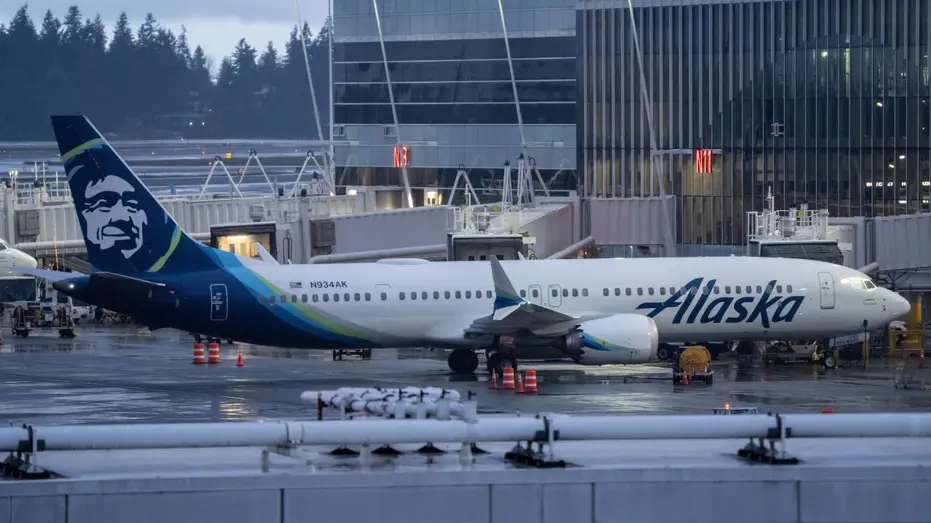a startling turn of events, the Boeing 737 Max9, poised to mark a significant milestone in American lunar exploration, has encountered a severe technical glitch. The aircraft, which recently made headlines for its involvement in a dramatic mid-air blowout, is now under scrutiny after air accident investigators revealed that restrictions were imposed on the passenger plane following warning lights reported by pilots on three previous flights. The aircraft’s panel door blew out mid-flight over the U.S. state of Oregon, landing in a residential backyard.
The incident has raised concerns about the safety of the Boeing 737 Max9, with the National Transportation Safety Board (NTSB) disclosing that the aircraft had already faced limitations on long-haul flights over water due to the reported warning lights. The gravity of the situation became apparent as a video taken by a passenger on board showed a sizable hole in the side of the plane where the panel had blown out.
During the flight, the pilot urgently communicated the need to return, stating, “We do need to return back to… We have 177 passengers.” Approximately 20 minutes later, Flight 1282 executed an emergency landing at Portland International Airport in Oregon, with fortunately no injuries reported.
Jennifer Hendy from the U.S. National Transportation Safety Board announced the discovery of the door plug, a crucial component found in a backyard. The retrieval of this section of the airframe becomes pivotal in understanding the root cause of the incident.
The repercussions of this event have not been limited to safety concerns alone. Boeing’s share price experienced a significant decline, plummeting by 9%, resulting in a staggering loss of $1.13 billion in stock market value. The impact extended beyond Boeing, affecting Alaska Air, which operates the Max9, causing the cancellation of 140 flights. Dr. Todd Curtis, a former Boeing safety engineer and founder of airsafe.com, shed light on the unfolding situation, emphasizing the complexity of aircraft and the challenges associated with their maintenance.
Dr. Curtis explained that any aircraft, even a new one like the 737 Max9, is a highly intricate piece of machinery. The 737 series, with a history spanning over 50 years, has undergone periodic maintenance checks, a standard procedure for ensuring the aircraft’s operational integrity. Despite routine maintenance, unforeseen issues can arise, leading to anomalies.
Addressing the recovery of the door or the missing section of the airframe, Dr. Curtis stressed its significance. The recovered component plays a crucial role in providing a comprehensive understanding of the events leading up to the incident. By analyzing the door plug, investigators can ascertain whether there was a manufacturing defect, overlooked maintenance, or any other issue that may have contributed to the mid-air blowout.
The unfolding narrative reveals that decompression lights had been flashing on three previous occasions in the cockpit, including once on the day before the incident. Dr. Curtis clarified that the NTSB, during a recent press conference, asserted that there was no direct link between the pressurization problem and the door problem. However, the fortuitous aspect was that the aircraft, due to the reported issues, was restricted from conducting Extended Overwater Operations (ETOPS) between the U.S. west coast and Hawaii. This restriction averted a potentially catastrophic scenario over the ocean.
Describing the likely scenario inside the cockpit during the incident, Dr. Curtis detailed the rapid decompression resulting from the blown-out door at 6,000 feet. The atmospheric pressure at that altitude is roughly half that on the Earth’s surface. The aircraft experienced chaotic conditions, with loose objects and papers flying throughout the cabin. Even critical checklists were ejected from the cockpit due to the force of the decompression.
Concerns have also been raised about the voice recorder, which was unfortunately overwritten after the incident. Dr. Curtis deemed this atypical, highlighting that voice recorders in the U.S. are mandated to store two hours of data. The failure to cut power to the voice recorder left it silently recording irrelevant information for the next two hours. This has been observed in previous serious incidents, reflecting a procedural lapse that needs attention.
The Boeing 737 Max9’s turbulent journey has been marked by a 20-month grounding following two fatal incidents outside the United States. Its return to service was already accompanied by widespread apprehension. Now, with the latest incident, questions arise about the future of the aircraft. Dr. Curtis acknowledges that the aircraft has a backlog of orders stretching several years, but customer concerns are valid. The 737 Max series faced two fatal crashes within 18 months of its service, making passengers understandably cautious.
In closing, Dr. Curtis draws a comparison with other aircraft models, emphasizing that the longevity between the introduction and the first fatal event is a critical factor. The 737 Max series faced two fatal incidents within a relatively short time frame, contributing to heightened public skepticism. As investigations unfold and Boeing navigates the aftermath, the aviation industry faces renewed scrutiny, underscoring the delicate balance between technological advancements and ensuring passenger safety.
